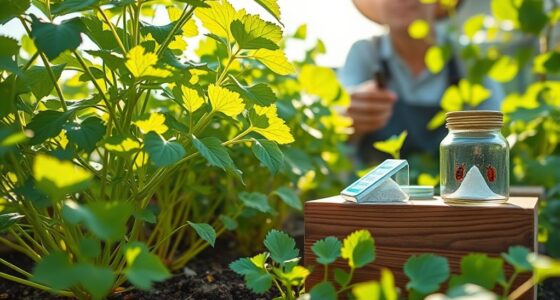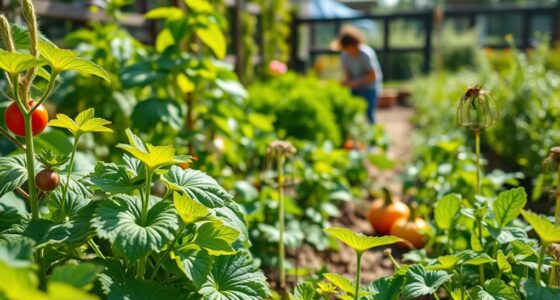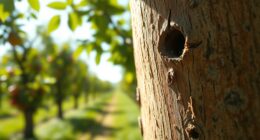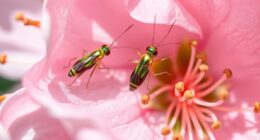Integrated Pest Management (IPM) is a smart, eco-friendly approach you can use to control pests in your garden. It combines biological controls like natural predators and beneficial insects, with regular pest monitoring to catch problems early. When needed, it focuses on targeted actions such as removing infested plants or introducing natural enemies, reducing the need for chemicals. If you want to discover more about creating a healthier, pest-free garden, keep exploring how IPM can work for you.
Key Takeaways
- IPM combines cultural, biological, and chemical methods to control pests sustainably and effectively.
- It emphasizes pest monitoring to detect early signs and prevent serious infestations.
- Biological control uses natural enemies like beneficial insects and nematodes to suppress pest populations.
- Actions are targeted and based on monitoring, such as removing infested plant parts or introducing predators.
- Combining monitoring with biological control reduces chemical pesticide use and promotes a healthy garden ecosystem.

Ever wondered how farmers and gardeners keep pests under control without relying solely on chemicals? The secret lies in integrated pest management, or IPM. This approach combines multiple strategies to manage pests effectively while minimizing environmental impact. Central to IPM is biological control, which involves using natural enemies like predatory insects, parasitic wasps, or beneficial nematodes to keep pest populations in check. Instead of applying pesticides indiscriminately, you introduce or encourage these helpful organisms, creating a balanced ecosystem that naturally suppresses pests. But biological control isn’t just about releasing beneficial insects; pest monitoring plays a vital role. Regularly inspecting your plants helps you identify pest presence early, so you can respond promptly and precisely. This proactive monitoring prevents pest populations from reaching damaging levels, reducing the need for chemical interventions.
Pest monitoring involves systematic observation of your garden or farm, looking for signs of pest activity or damage. It’s about becoming familiar with what healthy plants look like versus those showing signs of stress or infestation. When you detect pests early through monitoring, you can take targeted actions—such as removing infested leaves, introducing natural predators, or applying organic controls—before the problem escalates. This method keeps your pest management efforts efficient and environmentally friendly. Biological control and pest monitoring work hand-in-hand; monitoring informs you when and where to deploy biological agents, ensuring they are used effectively. For example, if you notice aphids on your lettuce, you might release ladybugs, which are voracious aphid eaters. Conversely, if pest levels are low, you can avoid unnecessary interventions, supporting a healthier garden ecosystem.
Frequently Asked Questions
Can IPM Be Used for Organic Gardening?
Yes, you can utilize IPM for organic gardening. It aligns with sustainable practices, focusing on minimizing chemical use and emphasizing natural controls. IPM helps protect your plants while maintaining organic certification standards. By monitoring pests, encouraging beneficial insects, and using organic-approved methods, you create a healthy garden ecosystem. This approach guarantees effective pest management without compromising your commitment to organic principles, supporting long-term garden health and environmental sustainability.
How Long Does It Take to See Results With IPM?
You might wonder how long it takes to see results with IPM. Timing expectations vary depending on pest types and infestation levels. With consistent pest monitoring, you can often notice improvements within a few weeks. Regularly inspecting your garden helps catch problems early, speeding up results. Remember, patience is key—IPM focuses on sustainable control, so gradual but steady progress is typical as you implement targeted strategies.
Is IPM More Cost-Effective Than Chemical Pesticides?
Ever notice how a small investment often leads to bigger savings? That’s true with IPM, which is more cost-effective than chemical pesticides. You’ll see cost savings over time, thanks to fewer chemical purchases and healthier plants. Plus, you enjoy long-term benefits like reduced environmental impact and pest resistance. So, choosing IPM means you’re not just saving money now, but setting your garden up for sustainable, hassle-free growth in the future.
What Are Common Mistakes to Avoid in IPM?
You should avoid neglecting proper pest identification and crop monitoring, as these are essential for effective IPM. Don’t assume all pests require the same treatment—misidentification can lead to unnecessary or ineffective methods. Also, skipping regular monitoring can cause pest populations to grow unchecked, making control harder later. Consistently observe your plants, accurately identify pests, and adapt your strategies accordingly to prevent mistakes and ensure successful IPM implementation.
Can IPM Be Integrated With Other Gardening Practices?
Like a modern-day Renaissance, you can seamlessly integrate IPM with other gardening practices. You should combine biological control techniques and pest monitoring to create a holistic approach. This synergy helps you reduce chemical use, promote plant health, and maintain ecological balance. By integrating these methods, you optimize pest management, making your garden more resilient and sustainable, all while keeping it vibrant and thriving.
Conclusion
By now, you see that integrated pest management isn’t just a myth but a proven, effective approach. It combines science, observation, and natural methods to keep pests in check without harming your garden or the environment. While some believe chemical controls are the only solution, research shows that IPM often outperforms them in both safety and sustainability. Give it a try—you might find it’s the best way to protect your plants and support a healthier garden ecosystem.









